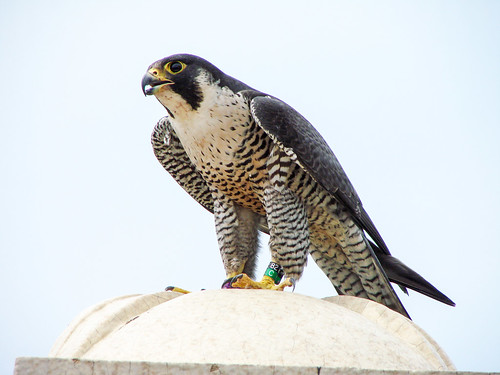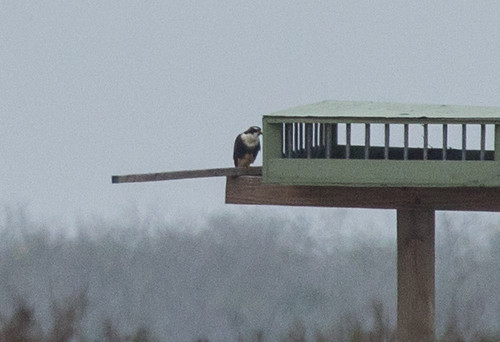 |
| One of downtown Duluth's famous Peregrine Falcons. The original releases in Minnesota were with the Peregrine Fund. |
In 1970, five years before I started birding, Peregrines were considered extirpated in the eastern United States; fewer than 40 pairs still remained in the West. I saw my lifer in Columbia County, Wisconsin, chasing a flock of plovers, in May 1977. I was helping lead a Madison Audubon field trip that day, and a boy needed me to sign his trip list to fulfill some high school science class requirement. The following Monday, his teacher called me, certain that the boy had fabricated the list because she knew that Peregrines were extinct. I had to explain to her that she was partly right: Peregrine Falcons no longer bred anywhere in most of the United States and were indeed considered extirpated in Wisconsin. Nevertheless, some still passed through on migration, and her student had definitely seen one with us. I also mentioned that it was that very boy who first noticed the chase, giving a bunch of us on the field trip a new and thrilling addition to our lifelist.
Thanks to Tom Cade, students telling their teachers that they’ve spotted a Peregrine are no longer suspected of lying. Dr. Cade, a falconer as well as a biologist, had a lifelong interest in falcons, which is why he founded the Peregrine Fund at Cornell in 1970, when things seemed dire indeed for the fastest known vertebrate on earth. Dr. Cade and others in the new organization started a captive breeding program at Cornell not to serve hobbyists but to restore the species to the wild. Once they had solidified techniques for getting falconers’ birds to reproduce in captivity, they started “hacking out” chicks from that captive rearing program. Between 1974 and 1997, the Peregrine Fund released more than 4,000 Peregrine Falcons into the wild. Those birds nesting in the eastern states all came directly from those releases.
From the time I took my first ornithology classes in 1975 and 1976, I knew of Cade’s work, and his reputation—a hero among ornithologists. I heard him give presentations at a few ornithological meetings I’ve attended, but I never had a chance to meet him. Wisconsin’s own ecological visionary, Stan Temple, was a student at Cornell when Cade started working there; Cade became Stan’s advisor as Stan worked on Peregrine studies and then when Stan, as a graduate student, headed to Mauritius to study its critically endangered kestrel.
And Stan’s studies on the Andean Condor, again working with Cade, were instrumental in beginning a protocol to raise California Condors in captivity—an essential component in bringing back this critically endangered species from the very brink of extinction. I’ll never forget being at the Zoology Museum in Madison when Stan brought in a prototype Andean Condor puppet that would be used to feed baby condors without them seeing their human caretakers. That creation back in 1980 or so led directly to my own thrilling experiences seeing wild condors thirty years later.
The only Aplomado Falcons I’ve ever seen in Texas were due to a release program spearheaded by the Peregrine Fund.
 |
| I have to go back to Texas to get better photos. This was a wild bird but probably originally was hacked out in this box. Now this handsome falcon seems to be holding its own. |
Isaac Newton famously said, “If I have seen further it is by standing on the shoulders of Giants.” And if I have seen falcons and condors and other raptors come back from near extinction, it’s been by standing on the shoulders of Tom Cade.

